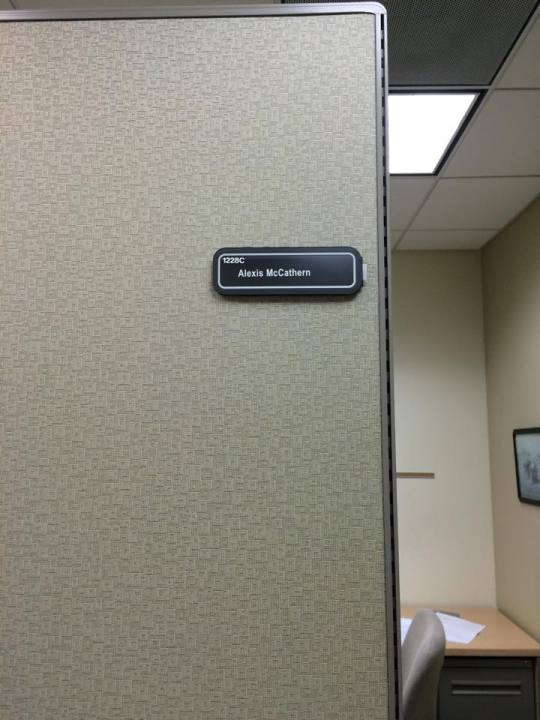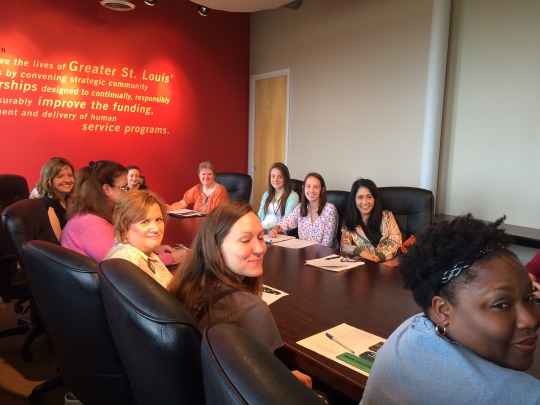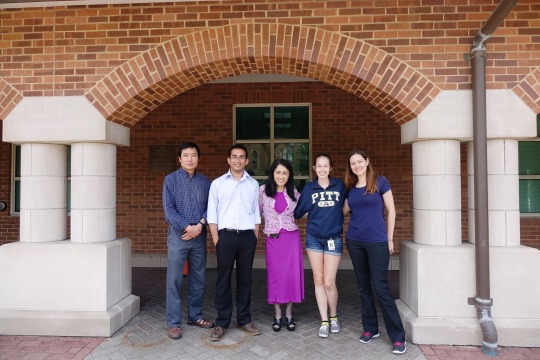Text
so nasa opened up applications to be an astronaut and all u have to have is a degree in the “right” field like ok nasa i see how it is u think an english lit major cant go to space well then tell me whos gonna analyze homoerotic subtext in space??? i kno theres homoerotic subtext in space ive seen star wars AND star trek
192K notes
·
View notes
Link
The (very important!) work that my mentor, Dr. Price, has been working on has gained some exciting media coverage! Read about how human trafficking is all around us and what is being done to stop it here. Additionally, Dr. Price has received a spotlight mention on WashU’s Institute for Public Health homepage about her recent funding: https://publichealth.wustl.edu/news/public-health-cubed-grant-awarded-to-study-human-trafficking/
2 notes
·
View notes
Photo










As I enter my final week of the PHASE/SPRINGH Fellowship, I thought I’d share a compilation of some photos depicting all the adventures I’ve been on while in St. Louis for the summer!
3 notes
·
View notes
Text
Look Beneath the Surface
On June 4 and 5, I, along with Dr. Price and Dr. Chaudhary (the pre-doc in my lab), attended the 4th Annual Regional Conference to Combat Human Trafficking. This two day conference was hosted by the International Institute and the St. Louis Rescue and Restore Coalition, an organization that the Price lab is partnering with for the Human Trafficking project. Throughout the conference, the conference collaborators were urging their motto, “look beneath the surface,” onto the audience, enforcing the idea that human trafficking occurs widely and often times in plain sight. The conference seemed to be geared more towards providers of human trafficking survivors, such as counselors, shelters, or other types of therapists, but it was still useful for me to learn about the culture behind human trafficking through all the seminars.
Throughout the two day period, I met a variety of professionals and heard many stories, facts, and movements that opened my eyes to the world of human trafficking. One anecdote that truly put the “look beneath the surface” motto into perspective for me was told by a fellow audience member in a break-out session I attended. This woman had volunteered at a domestic violence hotline. As a hotline volunteer, she worked from her home, located in what she described as a relatively wealthy, upper-middle class neighborhood. She described her most memorable call: a woman had called the hotline from inside her locked bathroom as she was hiding and trying to escape her sexually and physically abusive partner. The hotline volunteer promised she would stay on the phone with the caller until the police arrived. When the caller finally said that the police had arrived and she was safe, the hotline volunteer heard the wailing sirens of approaching police cars and watched them pull into a neighbor’s driveway. She made the connection that this type of severe domestic violence, and potential human trafficking, occurs everywhere. Survivors aren’t exclusively from a certain neighborhood, socioeconomic status, or race.
I found two additional lectures during the conference to be especially thought-provoking. The first was a lecture given by Kathleen Thimsen, a nurse and professor at the Barnes College nursing school. She talked about the importance of quality health care and easy access to health care for vulnerable populations. She specifically focused on elderly populations and human trafficking survivors. Survivors of human trafficking often have a criminal background, no insurance, little savings, and poor family support, all of which can hinder ability to obtain proper health care and services. Thimsen advocated for better screening procedures to identify a patient as a human trafficking survivor, more comprehensive follow-up diagnostics, and safer discharge for survivors. As a hopeful future-doctor, I feel these issues are extremely relevant to today’s society and emerging social issues and hope that I can work towards diminishing health care inequalities in my practice.
The second influential lecture for me was given by Amanda Colgrove, chairperson of the Coalition Against Trafficking and Exploitation (CATE). Dr. Price works closely with Colegrove and CATE on this human trafficking project. Colgrove shared her past research on mapping exploitation of sex trafficking and explained why reliable, quantitative data on human trafficking is necessary. Currently, various government agencies report “statistics” of the amount of trafficking and exploitation occurring, but due to a narrow legal definition, these figures are invalidated and unreliable. This lack of information impacts providers. Without reliable data, it becomes more difficult to write grants for additional funding to maintain their services. Without providers, it becomes difficult to support survivors with materials they need to reintegrate themselves into a healthy life. Colegrove’s lecture impacted the importance of the research I am doing. By mapping risk factors of human trafficking, I hope providers can find use of the map by identifying high-risk geographical areas and focus their efforts in those areas. Perhaps the map might help providers obtain additional funding, as well.
Overall, I found this two day conference on trafficking to be an extremely useful foundation for my research here in the PHASE program. I feel I have become more empathetic towards the situation of human trafficking, and enjoy this more human aspect into my research. Often, I find delving oneself into research runs the risk of losing the connection to the population that you are trying to help. This foundation, however, will hopefully keep the larger mission in perspective for me.
If you’re interested, here is a link to the conference's website where you can learn more about the break-out sessions and lectures I attended: http://www.stoptraffickingmo-il.org/conference.html
0 notes
Text
First Impressions
This week, I began my journey through the PHASE/SPRINGH Fellowship at Washington University in St. Louis through the Institute of Public Health and Medical School. During the orientation, I met my fellow peers, faculty from the Institute of Public Health, as well as my research mentor.
For the next two months, I will be working with Dr. Rumi Price on her newest research project, “ Human Trafficking in the St. Louis Metropolitan Area: Obtaining Quantitative Data.” This Human Trafficking research project is a new venture for Dr. Price as it deviates from her typical focus of study. I was initially drawn to Dr. Price due to her more prominent work with psychiatric disotders, mainly PTSD, and substance abuse. Her clinical, research, and academic background aligns with what I hope to accomplish in the next few years. At least, at this stage in my life. You can find a link to Dr. Price’s bio here and learn a little more about her. Dr. Price’s lab is located just on the skirts of the medical campus inside a building marked as the Central Institute for the Deaf.* (read below if you’d like to know why this is interesting to me, personally.)
I am excited to begin this Human Trafficking study with Dr. Price for a number of reasons, but most notably because it is such a pertinent and morally imperative subject in today’s world. The media coverage of domestic trafficking hubs and current legislative acts to reprimand traffickers and protect survivors is on the rise. To me, research seems to be the next logical step in diminishing human trafficking. Beyond the urgency of research on human trafficking, I am also eager to begin this project because it will be the first exposure to designing not only a brand new research project, but a research concept. In my past research experience, I have aided in designing new research paradigms, but never a new concept such as human trafficking for Dr. Price’s lab.
My specific objective for this two month period is to create a map of risk factors for human trafficking in the St. Louis metropolitan area, which includes southeastern Missouri and southwestern Illinois. Risk factors will include data such as high school retention rates, truancy rates, poverty levels, gender and race demographics, as well as other demographics. These data will be combined with geographical data through a software called Geographic Information Systems (GIS). I have never used a software of this kind, so I am ready to broaden my skills through my time in this lab.
During Orientation to the PHASE/SPRINGH program, I had the pleasure to meet 18 other awesome students with fascinating interests. Interests range from Harry Potter (obviously) to soccer to activism to chickens. I cannot wait to see what incredible projects they will accomplish at the end of these two months and hope I can make some deep connections and friendships in the process.
As an introduction to public health research, we had the pleasure of listening to Dr. William Powderly speak. I won’t drone on into details, but I will discuss a few points he made that made me fall in love with public health once more. At one point, Dr. Powderly explained that advancement of gender equality and care about furthering female education is imperative to the goal of sustaining public health. Women’s and human rights are really a public health issue. So, to me, you cannot really care about public and global health without being a feminist. I though it was a thought-provoking and powerful statement to start this program off with. Dr. Powderly also spent a short amount of time discussing one of my academic passions, HIV/AIDS research, which lead to an interesting discussion at the conclusion of his lecture. One fellow was stating how America often sets a poor example of stating public health and HIV research is a priority for us failing to fund important programs that help reduce the spread and risk of HIV, such as needle exchanges and safe injection sites. Dr. Powderly whole-heartedly agreed with her, and so do I. That’s why I passionately volunteer my time at Prevention Point Pittsburgh, a needle exchange located close to my campus. These seemingly unconventional, taboo establishments are really a strong driving force for public health initiatives.
Keep checking back for updates on my adventures in the lab and in St. Louis!
————————–
*When talking to Dr. Price about her lab located in CID and my American Sign Language skills, she said that since I’m familiar with deaf issues, I know that there are two schools of thought when it comes to educating deaf individuals. I identify with the school of ASL; teaching deaf children and deaf adults ASL will strengthen their self-esteem, enhance their ability to learn in school, and strengthen their sense of belonging in the Deaf community. The Deaf community is a proud community. They are proud of their unique language of ASL, and that is something I truly respect and try to become involved with. CID, on the other hand, subscribes to a more “oralist-centered” school of thought. As Dr. Price explained to me, the (hearing) physicians at CID forbid the use of ASL for their deaf patients for fear that “they will become ASL.” Now, to me, I do not see why these physicians see utilizing a new language as a negative thing. The Deaf community often feels that these oralists view deafness as a handicap, which it is not. It is just a human difference. I like to pose it as a white mother birthing a Latino child. Should we forbid that child from learning Spanish? A language that can connect that child to a culture they belong to but might otherwise never know? Being Latino is not a handicap, just a human difference. Food for thought.
2 notes
·
View notes